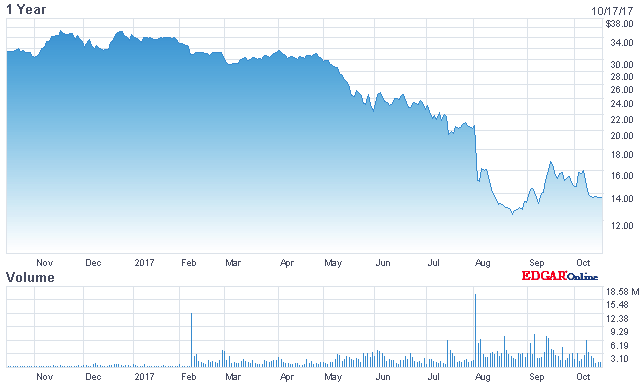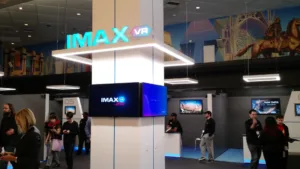In a recent press release, AMC Entertainment Holding Inc. and Dreamscape Immersive announced a partnership to bring VR experiences to the cinema complex. While this sounds like a natural fit at the first glance, let’s look at this announcement a little more closely.

On September 26, AMC and Dreamscape Immersive announced a sizeable investment by AMC. This includes AMC being the lead investor for the $20 million Series B investment round and financing up to 6 locations for Dreamscape Immersive. In addition they are committing $10 million to a content fund. While this adds up to $40 million, they are only the lead investor for round B, so the actual investment will be anywhere between $20 and $40 million.
AMC shares have not been blessed with following the general stock market trend this year. Instead the shares have been on pretty much a straight downward trend since the beginning of 2017. Actually, if they continue this trend, they would be a penny stock by the mid of 2018. It demonstrates that AMC management has some extra motivation to make the stock more attractive to investors. Being involved with a technology for the future may help to make investors feel better. So far, this has not happened and as a matter of fact the share price has gone down by another 10% since the announcement.
 AMC share price development – image from Nasdaq
AMC share price development – image from Nasdaq
Dreamscape Immersive, on the other hand, is a developer of virtual reality experiences backed by Steven Spielberg and a variety of studios with a total capital of about $11 million up to now. The Dreamscape solution allows up to six individuals to explore an VR environment and to interact within this environment via avatars. The motion capture technology was developed by the Swiss company Artanim and has attracted a lot of large size companies as investors, early on.
As reported by the New York Times, these VR experiences are designed to last about 9 minutes and cost about $1.5 to $2 million to produce. Tickets are expected to cost around $15 – $20, the article reports.
These experiences are not seen as a replacement of movies but as a complementing activity within the cinema. With movie tickets exceeding $10 in many places already, this will more than double the cost of a movie night, but adding just 9 minutes of entertainment. I am not trying to say that this is a bad idea, I am saying that in a time of a declining box office this may not be the home run that AMC is hoping for.
Extending the Experience
On the other hand, developing experiences that play together with a blockbuster movie maybe a good idea to extend the overall experience. For example, if some item is lost in the movie you can set out to retrieve that item, after the movie, in the VR experience together with your friends. I can see the attraction in that, if it is well integrated into the movie’s storyline. However, I have to ask how many people will sit around waiting for their turn?
When the movie is over, the first group of six enters the experience. Ten minutes later the next group comes in and so on. How long would the average person wait after the movie is over? Thirty minutes, an hour? Within an hour, 54 people would have been served per installation. This would add a revenue stream of $750 to $1,000 per hour and installation. Now, these installations need a certain space so increasing the number of installations within a movie cinema may not be as easy as it sounds.
At a first glance, this does not appear to be a great investment from a pure business perspective. Here is what I suspect may make this partnership a win–win situation.
Virtual reality is the hype topic in the technology world and bringing a good quality VR experience to the movie-going audience creates a positive first hand experience for VR. On the other hand, it adds a reason for people to go to the cinema in the first place and spend more time in the complex. More time may translate into more money being spent in the cinema. This is what AMC must be hoping for. In the short the run this equation may actually work.
The question is whether the cinema movie and VR environments are a natural match? That is where I have my doubts.
One is a more passive entertainment form that fits a large audience in a big room for an extended period of time. At the current time, VR is a more active and personalized form of entertainment where a single person, or in this case a small group of people spend a short period of time. These are two very different forms of entertainment and who favors one form may not be so happy with the other. I guess this is why AMC limits the investment to building only six VR environments, which are not necessarily located within a cinema.
Maybe VR is more of an alternative method of entertainment and will create its own platform going forward? In any case, VR as a location-based entertainment serves a much smaller group of people compared to the movie cinema. To make the associated cost structure work means the cost per person has to be much higher than movie ticketing and/or the entertainment time has to be much shorter. This is exactly what the NY Times article describes. NH
For another view on this topic, check out Chris’s early DD article Location-based VR is the Right Next Step.

